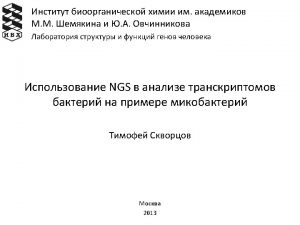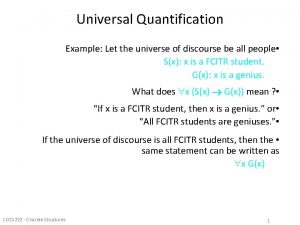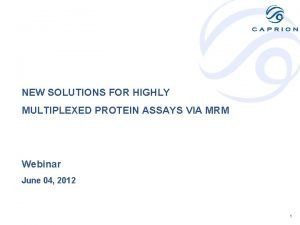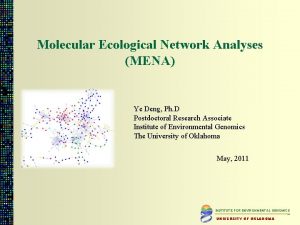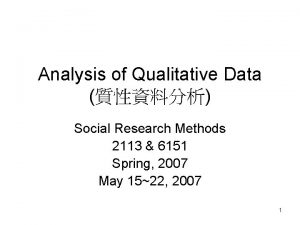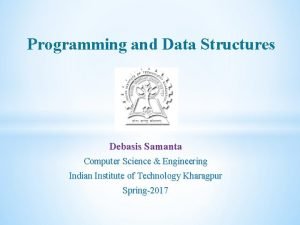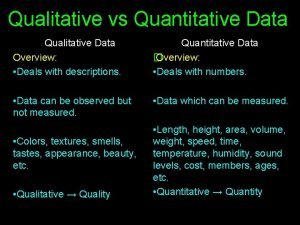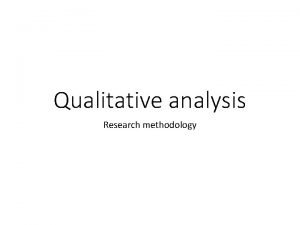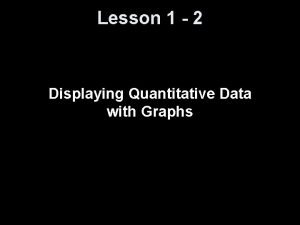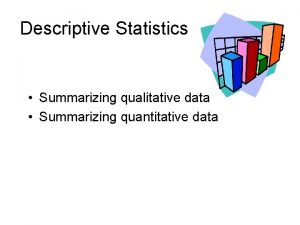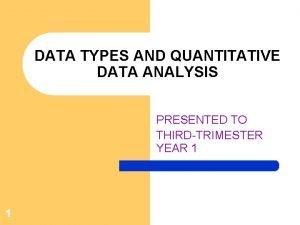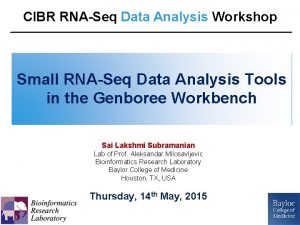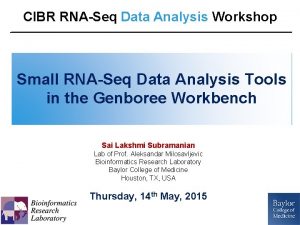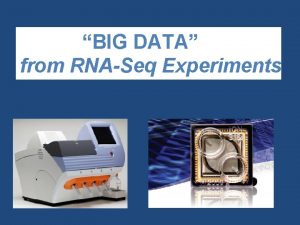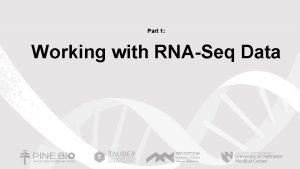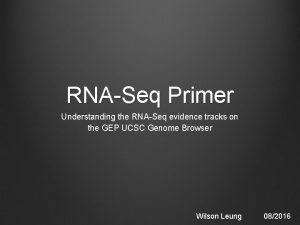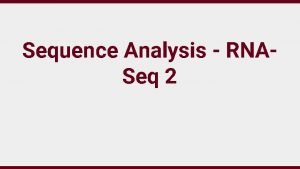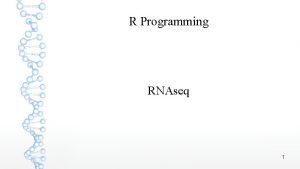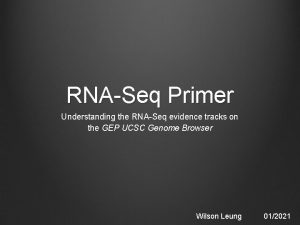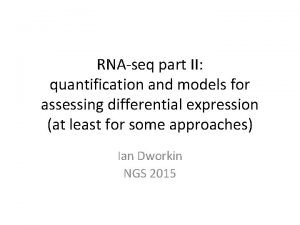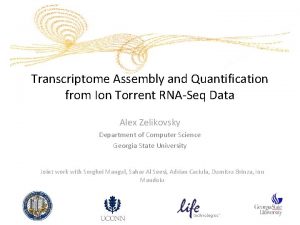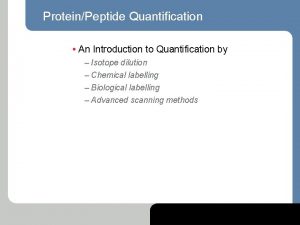Quantitative analyses using RNAseq data Classic quantification of

















![Salmon: Accounting for fragment sequence bias Love et al. (2016) Nature Biotechnology [Salmon] “It Salmon: Accounting for fragment sequence bias Love et al. (2016) Nature Biotechnology [Salmon] “It](https://slidetodoc.com/presentation_image/25d5a4c07cbda3b981f462c0aed4525e/image-18.jpg)

- Slides: 19

Quantitative analyses using RNA-seq data

Classic quantification of gene expression using RNA-seq Mapping Alignment to genome -Hisat 2 -STAR Counts reads per transcript Normalization FPKM Read counts tables TPM

Normalised expression values • For gene/isoform length Gene A Gene B Gene Raw reads Length Normalised Reads A 10 2 5 B 5 1 5 3

Normalised expression values • For total number of mapped reads Gene A Condition x Condition z Condition Raw reads Total mapped reads Normalised Reads x 10 1000 0. 01 z 5 500 0. 01 Gene A 4

FPKM (Fragment Per Kilobase Million) I STEP: normalize by depth GENE REP 1 REP 2 REP 3 A 1 (2 kb) 10 12 30 A 2 (4 kb) 20 25 60 A 3 (1 kb) 5 8 15 A 4 (10 kb) 0 0 1 5

FPKM (RPKM) I STEP: normalize by depth GENE REP 1 REP 2 REP 3 A 1 (2 kb) 10 12 30 A 2 (4 kb) 20 25 60 A 3 (1 kb) 5 8 15 A 4 (10 kb) 0 0 1 Sum all the counts 35 45 106 Scale by 1 M (10) 3. 5 4. 5 10. 6 6

FPKM (RPKM) II STEP: divide counts by scaling factor 3. 5 SCALING FACTOR 4. 5 10. 6 GENE REP 1 REP 2 REP 3 A 1 (2 kb) 2. 86 2. 67 2. 83 A 2 (4 kb) 5. 71 5. 56 5. 66 A 3 (1 kb) 1. 43 1. 78 1. 43 A 4 (10 kb) 0 0 0. 09 COUNTS -> FPM 7

FPKM (RPKM) III STEP: divide counts by length (kb) GENE REP 1 REP 2 REP 3 A 1 (2 kb) 1. 43 1. 33 1. 42 A 2 (4 kb) 1. 43 1. 39 1. 42 A 3 (1 kb) 1. 43 1. 78 1. 42 A 4 (10 kb) 0 0 0. 009 FPM -> FPKM 8

TPM (Transcripts Per Million) TPM is similar to FPKM and RPKM but it is calculated in a different order GENE REP 1 REP 2 REP 3 A 1 (2 kb) 10 12 30 A 2 (4 kb) 20 25 60 A 3 (1 kb) 5 8 15 A 4 (10 kb) 0 0 1 9

TPM (Transcripts Per Million) I STEP: normalize by gene length GENE REP 1 REP 2 REP 3 A 1 (2 kb) 5 6 15 A 2 (4 kb) 5 6. 25 15 A 3 (1 kb) 5 8 15 A 4 (10 kb) 0 0 0. 1 COUNTS -> FPK 10

TPM (Transcripts Per Million) II STEP: normalize by sequencing depth GENE REP 1 REP 2 REP 3 A 1 (2 kb) 5 6 15 A 2 (4 kb) 5 6. 25 15 A 3 (1 kb) 5 8 15 A 4 (10 kb) 0 0 0. 1 Sum all the FPKs 15 20. 25 45. 1 Scale by 1 M (10) 1. 5 2. 025 4. 51 11

TPM (Transcripts Per Million) II STEP: normalize by sequencing depth GENE REP 1 REP 2 REP 3 A 1 (2 kb) 3. 33 2. 96 3. 326 A 2 (4 kb) 3. 33 3. 09 3. 326 A 3 (1 kb) 3. 33 3. 95 3. 326 A 4 (10 kb) 0 0 0. 02 FPK -> TPM 12

FPKM VS TPM FPKM GENE REP 1 REP 2 REP 3 A 1 (2 kb) 1. 43 1. 33 1. 42 A 2 (4 kb) 1. 43 1. 39 1. 42 A 3 (1 kb) 1. 43 1. 78 1. 42 A 4 (10 kb) 0 0 0. 009 4. 29 TPM 4. 5 4. 25 GENE REP 1 REP 2 REP 3 A 1 (2 kb) 3. 33 2. 96 3. 326 A 2 (4 kb) 3. 33 3. 09 3. 326 A 3 (1 kb) 3. 33 3. 95 3. 326 A 4 (10 kb) 0 0 0. 02 10 10 10 13

Defying the paradigm of transcript quantification

Classic quantification of gene expression using RNA-seq Mapping Quasi-mapping to transcriptome Alignment to genome -Hisat 2 -STAR Counts reads per transcript Normalization TPM Salmon Bias correction and Quantification Read counts tables TPM

Quasi-mapping: Let speed up! • In many cases all the information provided for the alignment is not necessary. • Base-to-base alignment is slow and to quantify we just need to know the position where the reads map. • Quasi-mapping (Rap. Map) – Faster!!! – Produces mapping that meet or exceed the accuracy of existing popular aligners

RNA-seq biases Love et al. (2016) Nature Biotechnology
![Salmon Accounting for fragment sequence bias Love et al 2016 Nature Biotechnology Salmon It Salmon: Accounting for fragment sequence bias Love et al. (2016) Nature Biotechnology [Salmon] “It](https://slidetodoc.com/presentation_image/25d5a4c07cbda3b981f462c0aed4525e/image-18.jpg)
Salmon: Accounting for fragment sequence bias Love et al. (2016) Nature Biotechnology [Salmon] “It is the first transcriptome-wide quantifier to correct for fragment GC-content bias” Patro et al. (2017) Nature Methods

 Rnaseq illumina
Rnaseq illumina Vacuous quantification
Vacuous quantification Universe of discourse examples
Universe of discourse examples Highly multiplexed protein quantification
Highly multiplexed protein quantification Concln
Concln Critical thinking in nursing process
Critical thinking in nursing process Rhetorical analysis thesis
Rhetorical analysis thesis Courtage analyses services
Courtage analyses services Clutter distracts from the elements of your dish
Clutter distracts from the elements of your dish Qualitative and quantitative data analysis
Qualitative and quantitative data analysis Data
Data Debasis samanta data structure
Debasis samanta data structure Ualitative
Ualitative Qualitative vs quantitative data analysis
Qualitative vs quantitative data analysis Qualitative definition biology
Qualitative definition biology Difference between qualitative and quantitative data
Difference between qualitative and quantitative data Quantitative data graphs
Quantitative data graphs Summarizing qualitative data in excel
Summarizing qualitative data in excel Data types in quantitative research
Data types in quantitative research T test in quantitative research
T test in quantitative research
